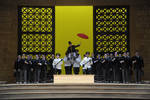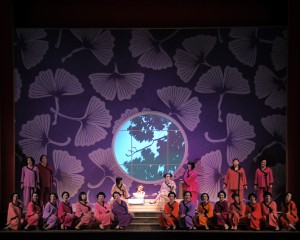
 [rating=4] While many theater patrons view “opera” as non-theater, I am of the belief that it should be considered in the same manner as musical theater is, for in reality that is what it is. Many operas of course are performed in languages other than English and thus are subtitled, but when the Lyric Opera does one that is in English, they still put the words on the very small screen above the stage, making the words clear for all ( in particular, the hard of hearing can enjoy the show as well) to see. One of their current productions is Gilbert and Sullivan’s operetta, “The Mikado” that was first performed in 1885, and first performed at Chicago’ Lyric Opera in 1983. While true opera patrons do not consider operetta in the same light, attracting audiences to the light nd frothy works of Gilbert and Sullivan is a great start at bringing your people to this famed building and maybe, will bring them to seek more opera.
[rating=4] While many theater patrons view “opera” as non-theater, I am of the belief that it should be considered in the same manner as musical theater is, for in reality that is what it is. Many operas of course are performed in languages other than English and thus are subtitled, but when the Lyric Opera does one that is in English, they still put the words on the very small screen above the stage, making the words clear for all ( in particular, the hard of hearing can enjoy the show as well) to see. One of their current productions is Gilbert and Sullivan’s operetta, “The Mikado” that was first performed in 1885, and first performed at Chicago’ Lyric Opera in 1983. While true opera patrons do not consider operetta in the same light, attracting audiences to the light nd frothy works of Gilbert and Sullivan is a great start at bringing your people to this famed building and maybe, will bring them to seek more opera.
For this production, the Lyric has brought in famed director Gary Griffin, who many theater patrons know for his work in our local theaters as well as his Broadway productions. He has taken this show to a little different level with very little scenery, costumes that with the exception of a few scenes are non-Japanese and getting a little more acting out of the singers that make up this cast. “The Mikado”, for those of you who are unfamiliar with it was created by Gilbert and Sullivan as to make a statement about the class system of England and the rules and laws considered unfair during their day, but was set in Japan to take the “edge” off. In this production, the “Gentlemen of Japan” are dressed alike with morning coats, derbies and of course umbrellas and attaches. The upper class male characters wear top hats, with the exception of “The Mikado” who wears military headcover. The story revolves around a young minstrel ( Toby Spence) who is in search of his beloved Yum-Yum ( a delightful performance by Andriana Chuchman) who he has fallen in love with. It turns out however, that she is to wed, Ko-Ko ( deftly handled by the incredible Neal Davies), the Lord High Executioner, who has been condemned to die because of a new law about flirting.
It gets even more contrived as we later find out that our young minstril is really the son and heir to The Mikado ( a powerful James Morris) but fled when he was advised that he was to marry Katisha ( Stephanie Blythe is absolutely amazing in this role and truly shows her versality) an older woman that he has no feeling for. When Ko-Ko is informed that since noone has been beheaded in almost a year, his job will become non-existent and the city will be reduced to a village, so there must be an execution, his! He must find a substitute. Nanki-Poo has declared that if he cannot marry Yum-Yum he will commit suicide, so Ko-Ko convinces him to be his substitute and will allow him to wed Yum-yum at least until his execution in one month. At this time, no one knows the real identity of Nank-Poo. Kattisha shows up and tries to reveal this to the people, but no one will hear what she says.
Act Two starts off with the preparation for the wedding and on this day it is announced that if a man is beheaded his wife must die by being buried alive. Yum-Yum is not so sure that she is ready, but Ko-Ko decalres they will stage that all this has taken place and they should leave town immediately. The Mikado and Katisha arrive and after being told about the execution ( to save the town) Ko-Ko is informed that nanki-Poo was in fact the Mikado’s son. Nanki-Poo and Yum-Yum return and advise Ko-Ko that is he should wed Katisha , she will no longer come after him and he can return to be alive. Ko-Ko does so and all is happy at the end. The story is about class and identity and how common people were abuse during those times and Gilbert and Sullivan used this story to express their feelings. Meanwhile, Griffin with his stellar cast and keen eye for detail has brought a masterpiece to the Lyric stage.
The ensemble/chorus is strong andwhile not used to “acting” as much as singing, Griffin was able to get them to add movement to their stage appearances. Other stand-outs in the cast: Philip Kraus, The very comical Andrew Shore, Emily Fons and Katherine Goeldner. The set (Mark Thompson, who also did the wonderful costumes) is pretty simple and allows the audience to hear the words and watch the actions instead of looking at spectacle. To often, directors rely on glitz and forget about the content; in other words, they sell the sizzle over the steak itself. Griffin gives us the steak and a very juicy morsel it is.
“The Mikado” runs in reertoire so to get specific information on dates, times and tickets, visit www.lyricopera.org







More Stories
“Guys & Dolls”
“The Music Man”
“Birds, Frogs,Crickets, & Dogs”- Music of the Baroque reviewed by Julia W. Rath